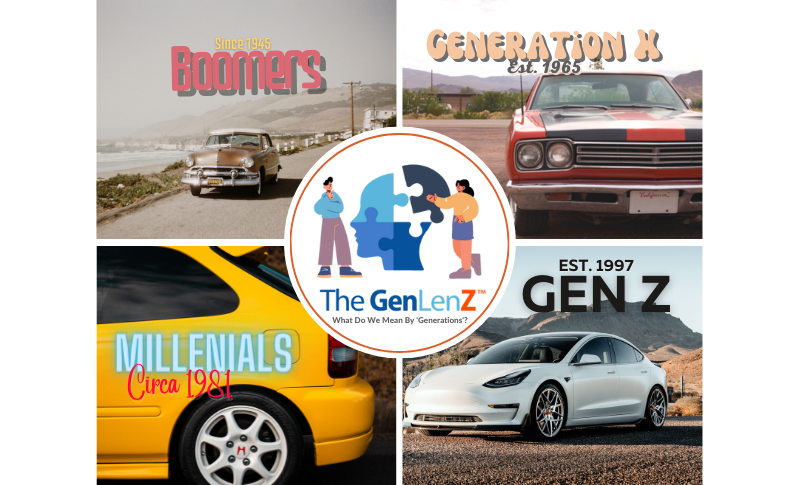Written by: Brayden Foreht, Gatekeeper | Content R&D, JGC
Etymology of “Generation”: From Ancestral to Social
The term “generation” is so widespread and ingrained in today’s culture that when you see or hear it, you likely think “millennial”. It’s a term intuitively understood these days, yet simultaneously difficult to define. Perhaps that’s because it’s a loaded term, packed full of concepts and connotations. Or perhaps it’s become taken for granted, and few contemplate or reflect on its meanings and impacts.
Considered even less is how and when the term picked up the baggage it currently carries, which could shed a lot of light on why it became (and remains) such a phenomenon. So, how did “generation” come to mean what it does? I see no better place to begin our investigation into the nature and usefulness of generational categories than here.
Originally, the word was used in the genealogical sense, segmenting successive waves of reproduction in familial/ancestral structures. For example, your grandparents comprise one generation, your parents and their siblings the next generation, and you, your siblings and your cousins the new generation. Once the latter lot reproduce, those offspring will be categorized as the newest, youngest generation within the kinship. Generally, such reproductive waves come every 30 years (roughly). Towards the end of the Enlightenment, (that period during which science and rational thought became mainstream in Europe), philosophers started applying this notion to society to theorize about their newfound curiosity with social/cultural change. They theorized that social change occurs due to people changing every 30 years. Thus, “generation” began to be used in the social-chronological sense with which we are so familiar today.
Social Generations and Change: Cause, Effect or Both?
The philosophical study of generations during the Enlightenment had two schools of thought that disagreed on whether generations are the cause, or the effect, of social change. One view was that social change is instigated by the ushering in of new generations who think and do things differently while phasing out some older thinking and practices. In this sense, generations are the heart of historical-social change, keeping society churning and evolving. In the other view, generational differences are a product of the shared historical events they experienced. In this view, historical and social change imprints upon the people of the time, which is the ultimate factor responsible for the evolution of different generations.
While neither view can ever be proven, there are remnants of both views in the ways that generations are thought about and discussed today. Think about it for a moment. Think about your (great) grandparents’ generation. Don’t we share the perception that they are the way they are partially due to having lived through the Great Depression and WWII? Yet on the same note, don’t we also share the perception that the ‘younger’ generation sees things differently and are likely the agents – challenging traditional thinking and ultimately initiating change?
It’s important to note that when discussing large-scale change, it’s almost always the younger or ‘most new’ generation that is seen as the driver. Right now, Gen Z are the ones who ‘think differently, strongly desire change and will do what is necessary to achieve it’. It’s ‘Managing Gen Z’ you’re reading about online. Yet 10-20 years ago, it was Millennials who were going to change the world and needed to be understood. And 20 years before that, it was Gen X. Following this train of thought, aren’t generations just a fancy re-labelling of “youth culture”?
Labels & Culture: When Media Catches On
In the early 1900s, there was no youth culture. In fact, there really didn’t exist a life stage between being a dependent and being an adult – only 10% to 15% of high-school aged kids remained in school, while the remainder were in the workforce. However, by the time WWII was over, roughly 70% of high-school aged students were in school, and by 1960 it was nearly 90%. Coupled with the extreme birth-rate increase beginning in 1946 (that’s right, the Baby Boom) and you have the perfect recipe for a new life stage being born: adolescence, perfectly slotted between complete dependence and adulthood.
Naturally, different life stages embody different values, interests, customs – and ultimately behaviours. So, when a new life-stage is formed, so too are a set of values, interests, customs, and behaviours unique unto its cohorts. And with that comes the opportunity to target this new life-stage with markets and marketing that speaks to them specifically. This was exacerbated during the 50s and 60s when another life stage formed between adolescence and adulthood – “young adulthood” – as more and more high-school grads enrolled in college. Effectively though, the two shared enough of the same behaviours et al. that they were treated simply as one: youth culture.
By the time the 70s rolled around, roughly a fifth of the population fit in the youth age range. With the rise of neoliberalism and the resulting boom in the free-market private sector over the years, such a sizable consumer base could not be ignored. In fact, it was catered to, with companies and industries formed around the market interests of the ‘new, young generation’. As an extension of this, sub-cultures within youth culture began appearing, some of which ironically were a product of the marketing-centric, consumer capitalism off which they initially obtained their identity/label. Think about it – the roller skaters existed only because companies marketed and sold roller skates and roller skating experiences to the youth. The same is true of more modern examples, like the ‘Tamagotchi Kids’ or today’s ‘gamers’.
On the topic of labels, the generational ones “stuck”, thanks to a non-scientific process involving journalists, authors, and advertising campaigns. The origin of “Silent Generation” is from a Time magazine article from 1951. “Baby Boomer” is of course linked to the “baby boom” and was referenced in newspapers throughout the 60s. Both “Generation X” and “Millennials” were coined in books. The former is derived from a novel of the same name, and the latter from Straus and Howe’s popular and influential book on the generational cycles in the US over the past 400 years. Both were published in 1991. It was this book that popularized the generational terms as we know them today, with each label encompassing distinct traits. The spread and further popularization of these labels – and thus supposed differences between generations – was spurred by the internet and technology boom, making it more common and much easier to be exposed to seeing, hearing, and reading about such. Accordingly, over the past three decades, there has been quite an uptick in generational marketing content, consulting, and advice – but is it of any value?
That’s exactly what we’re going to look at in the next article. More specifically, we’ll consider some factors that impact the validity of generational categorizations while determining what really matters when trying to segment people into groups.
#JGC4B2B #Marketing #TheGenLenZ #Print #Millennials #GenZ #GenX #Boomers #Generations #Sales




